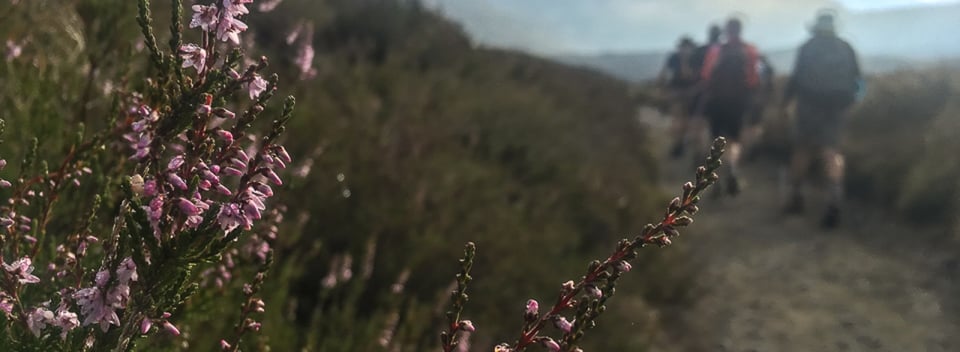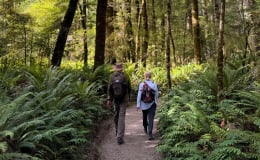
Spring in New Zealand – A Special Time of Year!

What makes springtime so special in New Zealand, why it’s one of our favourite times of year down here and why you should plan to visit New Zealand during the spring months.
Springtime. The very mention of the word conjures up images of new life, fresh growth and warm sunshine. Over the ages many authors have been inspired to put pen to paper extolling the virtues of spring or using it as a metaphor for hope and potential. While this blog post might not be quite as lyrical or poetic as all that, it doesn’t change the fact that spring is worth shouting about. And springtime in New Zealand even more so!

A familiar sight around New Zealand towns during Spring - big, beautiful cherry blossoms
Spring is undoubtedly a special season for us and we think that everyone should have the chance to experience all that New Zealand has to offer during it. The weather, wildlife, plant life and natural features of the land are all are their best, plus with less people on the trails and cheaper flight options available, what’s not to love about a springtime trip to New Zealand?
Weather
Our spring season here at New Zealand Trails kicks off in October and runs through to late November. Spring weather in New Zealand can be somewhat hard to predict, there can be the odd rain shower or even snowfall mixed in with the glorious sunshine. Usually the rain doesn’t set in for long, so while it’s worth packing your waterproof jacket, you certainly won’t be wearing it the whole time you’re here. If you want to find out more about what to expect from the weather in Spring check out our blog about the best time to visit New Zealand.
It’s been said that often here in New Zealand you may experience four seasons in one day and personally I think there’s nothing more refreshing than a brief rainfall, before the clouds part to reveal blue skies, warm sun and often the arc of a rainbow. Plus, if you have a keen photographic eye, capturing those rain drops beading off fresh green grass stalks or wildflower petals is a great challenge.
Temperatures in spring vary between the North and South Islands of New Zealand. Overall though it’s mild from October through to November. Typically, it’s a little warmer up on the North Island than further south. With an average daytime temperature ranging between 17-21°C (62-70°F) and warming up even more as summer approaches, conditions are ideal for exploring. Imagine sipping a local wine in the afternoon sun at a Waiheke winery or hiking a trail past turquoise mountain lakes on the Tongariro Crossing (we visit here on day 4 of our Sweet North trip)!

Emerald Lake, at the business end of the Tongariro Crossing
Down on the South Island, you can expect slightly cooler starts in the morning with the odd frost here and there. Once the sun’s up, temperatures usually sit between 12-18°C (55-65°F) during the day in most places. With summer just around the corner as we head into November, temperatures tend to settle around the low 20s (70°F). So, you’d be more than comfortable hiking the Routeburn Track through ancient beech forests and alongside crystal-clear alpine streams in a light jacket and shorts. The sun’s very strong here, so don’t forget to put on your sunscreen.
Aside from the temperatures, which admittedly are prone to being somewhat skittish, spring weather in New Zealand brings with it fresh breezes, bright blue skies and crystal-clear air that allows you to appreciate the views for miles around. There’s often a fresh dusting of snow on the mountain peaks too, which provides a stunning backdrop as you enjoy the trails on your trip.
Plant Life
The inimitable Robin Williams said that “spring is nature’s way of saying, ‘let’s party!’” And I reckon New Zealand’s diverse array of plant life would have to agree. Wildflowers are blooming, fresh green grasses are sprouting, deciduous trees are waking up from their winter hibernation and there’s a real feeling of new life all around. It really is plant party time!
One of the most photographed of all our wildflowers during spring would have to be the lupin. An introduced species with a somewhat controversial history, it flowers from November onwards. You’ll see vast fields of pink, purple, blue and white blooms stretching on to the horizon line. Framed by a background of snow-capped mountain peaks and lush forests, it truly is an impressive sight.

One of many fields of Lupins you'll see in Spring - this one is near Lake Tekapo
Of course, in spring you’re always find cheerful rows of daffodils popping their heads up, but we also have a vast array of native trees, plants, flowers, shrubs, ferns and mosses, many of which gain a new ‘spring’ in their step after winter. Our unofficial national flower, the native Kowhai also blooms during the spring months – its brilliant bright yellow flowers attracting all manner of little birds such as the fantail, tui and bellbird. From October onwards, the endemic Harakeke (flax) also puts out large orange red flowers which really get the native birds excited!
80% of our tree and plant life is found only in New Zealand and with expert local guides to show you the best spots to soak it all in, plus the gorgeous spring weather to complement the experience, you’re bound to enjoy yourself.
Wildlife
You can’t speak about spring without mentioning lambs, it would be a crime. I know technically they’re not wild, but they’re too adorable to ignore. New Zealand is famous for its population of sheep, providing us with not only the superbly practical merino wool, but also a tasty Sunday roast option (lambs, cover your ears!) Aside from those uses, they are also a tremendous source of entertainment, particularly during lambing season. From early September onwards, you’ll start to notice teeny bundles of fun in lamb form appearing like popcorn in fields right up and down the country. You can’t help but laugh as you watch them charging up and down together, frolicking around before collapsing on the sweet grass for a well-deserved nap in the sun. If you join us on our Masterpiece tour during spring, you might even get a chance to bottle feed one of these joyous little creatures at working high county station Mount Nicholas.

The lambs here at Mt Nicholas Station certainly grow up with an epic view!
Enough about lambs though, we all know they’re cute. What other wildlife can you hope to see during a New Zealand spring? New Zealand is home to over 40 endemic birds, including the iconic kiwi, cheeky kea and curious kakapo. Whilst it’s possible to spot these birds year-round, often the first flush of spring growth means they’re livelier during this time. Chicks are hatching, so hard working parents are busy collecting food and you’re more likely to spot them in action. Of course, this means that our busy birds deserve peace and ample space from us, but you’ll find that the places we visit on our trips allow for that in a natural and tranquil setting. Okarito Lagoon is one of the best spots in New Zealand for viewing birdlife in its natural habitat. Gliding along silently in comfortable kayaks with the sun glistening on the calm waters, there’s no better chance to politely observe the rare kotuku (white heron) or one of the other 70 species making their home in and around Okarito.
The New Zealand fur seal is another creature you’ll meet during spring, basking in the sun and resting before their pups arrive around mid-November. Once hunted to point of extinction by early European settlers, their numbers are now stable and gradually increasing, which means we can happily observe them in all their blubbery glory. Join us on our World Heritage for a once in a life time experience as we helicopter to remote Martins Bay in Fiordland National Park to meet the resident colony of fur seals. And what better time than spring to witness them at home in the water and relaxing on the rocks.
Waterfalls
New Zealand boasts a variety of stunning natural waterfalls from north to south, so you’re never too far from the sound of cascading water. During the spring months, these tumbling towers of clear water are at their finest. With snow melt from the mountain peaks and a little additional rainfall, you’ll be astounding at the thundering falls and powerful torrents of water during spring.

The magnificent Stirling Falls in Milford Sound, the second-tallest permanent fall in the Sound
Fiordland National Park and Milford Sound in particular, is home to some of our most impressive waterfalls. The tallest and arguably most spectacular is Bowen Falls, dropping some 162 metres to the sea and providing Milford’s small settlement with its power and water source. The second tallest is Stirling Falls at 151 metres in height. It’s best viewed from the deck of a boat which will take you close enough to feel the spray on your face. During spring, there’s no better way to enjoy Milford’s many waterfalls than cruising the sound aboard a boat and hearing the sounds of these watery giants as they plummet to earth – an experience you won’t forget on our Pure South trip.
Quiet Trails and Cheaper Flights
Aside from the abundance of natural delights that spring brings with it, there are also a few unexpected perks to travelling to our shores from October through November, into early December. While some in the travel industry might consider spring to be the ‘shoulder’ season, not so at New Zealand Trails - we love it!
New Zealand is not a crowded place, even during the height of summer there’s always a quiet spot to enjoy the views. But during the spring months, before the kiddies are on their summer holidays and most selfie-stick wielding tourists arrive, you’ll quite often get the pristine tracks and trails all to yourself. What could be better than marvelling at a majestic mountain view in the company of a small group of like-minded travellers, without another soul around for miles – bliss if you ask me! Out on the trail the only sounds you’re likely to hear are the breeze in the trees, the call of a forest bird or the rushing of a trackside stream. I can’t guarantee complete isolation (you’d have to head to Stewart Island for that) but you’ll find a trip taken during the spring months will be a lot quieter than a high summer adventure.
As an additional and welcome bonus to the springtime serenity, you’ll notice that flight prices are usually a little lower too. It’s worth shopping around to get a good deal and keeping an eye out for sales. If you'd like to take the research and stress out of booking flights, just make it easy on yourself and talk to our experienced team who are happy to help.
Hopefully after reading this post, you’ll have a good understanding of why the team at New Zealand Trails are so passionate about our little country and especially so during spring. As a band of happy kiwis, we’re typically even cheerier during the spring months! That’s not to say that if you come to New Zealand any other time, we won’t be as friendly, it’s just you might notice a little extra pep in our step from October onwards. For those of you that can’t make it down here during spring, all is not lost. You’ll still have an incredible time no matter when you come, I promise.
Still unsure and want some guidance? Take a look at our Which Trip is Right For Me page to compare our trips side-by-side. Or, if you already know you want to secure your spot, you can choose your date by visiting our availability page.
Request your FREE NEW ZEALAND TRAILS Brochure here now for articles, stories and information on our 5 guided trip options.








